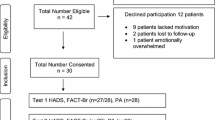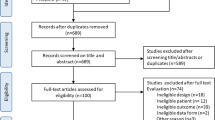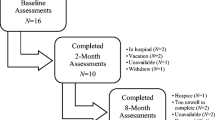Abstract
Background Performance status (PS) scoring systems are tools of immense clinical importance in the management of patients with malignant disease but these tools are subjective and do not provide an objective evaluation of physical functioning. We conducted a pilot study to explore the feasibility and clinical utility of functional capacity testing to assess physical functioning in recurrent primary malignant glioma patients. Patients and methods Using a cross-sectional design, consecutive patients with recurrent glioma performed a six minute walk (6MW) test to assess functional capacity. Performance status was assessed using Karnofsky Performance Status (KPS) scoring system. QOL was assessed by the Functional Assessment of Cancer Therapy-Brain scale. Self-reported exercise behavior was assessed using the Godin Leisure Time Exercise Questionnaire (GLTEQ). Results A total of 171 patients were recruited and tested. Seventy percent were diagnosed with glioblastoma multiforme (WHO grade IV) and 85% were undergoing therapy. Median KPS was 90% (range, 70–100%). Median 6MW distance was 400 m (range, 102–630 m), equivalent to 56 ± 13% (range, 14–87%) of that predicted for age and sex. KPS, self-reported exercise, and QOL increased across 6MW distance quartiles (P < 0.05) although there was considerable variation within each category. 6MW distance and KPS were significantly correlated with each other (r = 0.34, P < 0.01) and several QOL domains (range, r = −0.43 to 0.46, P < 0.05). Conclusions 6MW distance is a clinically feasible tool that provides an objective measure of physical functioning in select patients with recurrent glioma. Further research is required to investigate the prognostic value of these tests in patients with advanced malignancy.
Similar content being viewed by others
References
Gorlia T, van den Bent MJ, Hegi ME, Mirimanoff RO, Weller M, Cairncross JG et al (2008) Nomograms for predicting survival of patients with newly diagnosed glioblastoma: prognostic factor analysis of EORTC and NCIC trial 26981-22981/CE.3. Lancet Oncol 9(1):29–38. doi:10.1016/S1470-2045(07)70384-4
Curran WJ Jr, Scott CB, Horton J, Nelson JS, Weinstein AS, Fischbach AJ et al (1993) Recursive partitioning analysis of prognostic factors in three Radiation Therapy Oncology Group malignant glioma trials. J Natl Cancer Inst 85(9):704–710. doi:10.1093/jnci/85.9.704
Scott CB, Scarantino C, Urtasun R, Movsas B, Jones CU, Simpson JR et al (1998) Validation and predictive power of Radiation Therapy Oncology Group (RTOG) recursive partitioning analysis classes for malignant glioma patients: a report using RTOG 90-06. Int J Radiat Oncol Biol Phys 40(1):51–55. doi:10.1016/S0360-3016(97)00485-9
Buckner JC (2003) Factors influencing survival in high-grade gliomas. Semin Oncol 30(6 Suppl 19):10–14. doi:10.1053/j.seminoncol.2003.11.031
Filippini G, Falcone C, Boiardi A, Broggi G, Bruzzone MG, Caldiroli D et al (2008) Prognostic factors for survival in 676 consecutive patients with newly diagnosed primary glioblastoma. Neuro Oncol 10(1):79–87. doi:10.1215/15228517-2007-038
Donato V, Papaleo A, Castrichino A, Banelli E, Giangaspero F, Salvati M et al (2007) Prognostic implication of clinical and pathologic features in patients with glioblastoma multiforme treated with concomitant radiation plus temozolomide. Tumori 93(3):248–256
Nieder C, Astner ST, Molls M, Grosu AL (2007) Analysis of long-term survivors of glioblastoma multiforme in a single institution with aggressive local retreatment protocol. Anticancer Res 27(4C):2993–2996
Kaasa T, Wessel J (2001) The Edmonton Functional Assessment Tool: further development and validation for use in palliative care. J Palliat Care 17(1):5–11
Abernethy AP, Shelby-James T, Fazekas BS, Woods D, Currow DC (2005) The Australia-modified Karnofsky Performance Status (AKPS) scale: a revised scale for contemporary palliative care clinical practice ISRCTN81117481. BMC Palliat Care 4:7. doi:10.1186/1472-684X-4-7
Schag CC, Heinrich RL, Ganz PA (1984) Karnofsky performance status revisited: reliability, validity, and guidelines. J Clin Oncol 2(3):187–193
Yates JW, Chalmer B, McKegney FP (1980) Evaluation of patients with advanced cancer using the Karnofsky performance status. Cancer 45(8):2220–2224. doi:10.1002/1097-0142(19800415)45:8<2220::AID-CNCR2820450835>3.0.CO;2-Q
Whitton AC, Rhydderch H, Furlong W, Feeny D, Barr RD (1997) Self-reported comprehensive health status of adult brain tumor patients using the Health Utilities Index. Cancer 80(2):258–265. doi:10.1002/(SICI)1097-0142(19970715)80:2<258::AID-CNCR14>3.0.CO;2-T
Giovagnoli AR, Tamburini M, Boiardi A (1996) Quality of life in brain tumor patients. J Neurooncol 30(1):71–80. doi:10.1007/BF00177445
Mackworth N, Fobair P, Prados MD (1992) Quality of life self-reports from 200 brain tumor patients: comparisons with Karnofsky performance scores. J Neurooncol 14(3):243–253. doi:10.1007/BF00172600
Mauer M, Stupp R, Taphoorn MJ, Coens C, Osoba D, Marosi C et al (2007) The prognostic value of health-related quality-of-life data in predicting survival in glioblastoma cancer patients: results from an international randomised phase III EORTC Brain Tumour and Radiation Oncology Groups, and NCIC Clinical Trials Group study. Br J Cancer 97(3):302–307. doi:10.1038/sj.bjc.6603876
Mauer ME, Taphoorn MJ, Bottomley A, Coens C, Efficace F, Sanson M et al (2007) Prognostic value of health-related quality-of-life data in predicting survival in patients with anaplastic oligodendrogliomas, from a phase III EORTC brain cancer group study. J Clin Oncol 25(36):5731–5737. doi:10.1200/JCO.2007.11.1476
Taphoorn MJ, van den Bent MJ, Mauer ME, Coens C, Delattre JY, Brandes AA et al (2007) Health-related quality of life in patients treated for anaplastic oligodendroglioma with adjuvant chemotherapy: results of a European Organisation for Research and Treatment of Cancer randomized clinical trial. J Clin Oncol 25(36):5723–5730. doi:10.1200/JCO.2007.12.7514
McCarter H, Furlong W, Whitton AC, Feeny D, DePauw S, Willan AR et al (2006) Health status measurements at diagnosis as predictors of survival among adults with brain tumors. J Clin Oncol 24(22):3636–3643. doi:10.1200/JCO.2006.06.0137
Ross RM (2003) ATS/ACCP Statement on cardiopulmonary exercise testing. Am J Respir Crit Care Med 167(2):211–277. doi:10.1164/rccm.167.2.211
Lederer DJ, Arcasoy SM, Wilt JS, D’Ovidio F, Sonett JR, Kawut SM (2006) Six-minute-walk distance predicts waiting list survival in idiopathic pulmonary fibrosis. Am J Respir Crit Care Med 174(6):659–664. doi:10.1164/rccm.200604-520OC
Lettieri CJ, Nathan SD, Browning RF, Barnett SD, Ahmad S, Shorr AF (2006) The distance-saturation product predicts mortality in idiopathic pulmonary fibrosis. Respir Med 100(10):1734–1741. doi:10.1016/j.rmed.2006.02.004
Flaherty KR, Andrei AC, Murray S, Fraley C, Colby TV, Travis WD et al (2006) Idiopathic pulmonary fibrosis: prognostic value of changes in physiology and six-minute-walk test. Am J Respir Crit Care Med 174(7):803–809. doi:10.1164/rccm.200604-488OC
Cote CG, Pinto-Plata V, Kasprzyk K, Dordelly LJ, Celli BR (2007) The 6-min walk distance, peak oxygen uptake, and mortality in COPD. Chest 132(6):1778–1785. doi:10.1378/chest.07-2050
Jones LW, Eves ND, Haykowsky M, Joy AA, Douglas PS (2008) Cardiorespiratory exercise testing in clinical oncology research: systematic review and practice recommendations. Lancet Oncol 9(8):757–765
ATS Committee on Proficiency Standards for Clinical Pulmonary Function Laboratories (2002) ATS statement: guidelines for the six-minute walk test. Am J Respir Crit Care Med 166(1):111–117
Gibbons WJ, Fruchter N, Sloan S, Levy RD (2001) Reference values for a multiple repetition 6-minute walk test in healthy adults older than 20 years. J Cardiopulm Rehabil 21(2):87–93. doi:10.1097/00008483-200103000-00005
Weitzner MA, Meyers CA, Gelke CK, Byrne KS, Cella DF, Levin VA (1995) The Functional Assessment of Cancer Therapy (FACT) scale. Development of a brain subscale and revalidation of the general version (FACT-G) in patients with primary brain tumors. Cancer 75(5):1151–1161. doi:10.1002/1097-0142(19950301)75:5<1151::AID-CNCR2820750515>3.0.CO;2-Q
Yellen SB, Cella DF, Webster K, Blendowski C, Kaplan E (1997) Measuring fatigue and other anemia-related symptoms with the Functional Assessment of Cancer Therapy (FACT) measurement system. J Pain Symptom Manage 13(2):63–74. doi:10.1016/S0885-3924(96)00274-6
Godin G, Jobin J, Bouillon J (1986) Assessment of leisure time exercise behavior by self-report: a concurrent validity study. Can J Public Health 77(5):359–362
Godin G, Shephard RJ (1985) A simple method to assess exercise behavior in the community. Can J Appl Sport Sci 10(3):141–146
American College of Sports Medicine Position Stand (1998) The recommended quantity and quality of exercise for developing and maintaining cardiorespiratory and muscular fitness, and flexibility in healthy adults. Med Sci Sports Exerc 30(6):975–991. doi:10.1097/00005768-199806000-00032
Jones LW, Eves ND, Mackey JR, Peddle CJ, Haykowsky M, Joy AA et al (2007) Safety and feasibility of cardiopulmonary exercise testing in patients with advanced cancer. Lung Cancer 55(2):225–232. doi:10.1016/j.lungcan.2006.10.006
Win T, Jackson A, Groves AM, Sharples LD, Charman SC, Laroche CM (2006) Comparison of shuttle walk with measured peak oxygen consumption in patients with operable lung cancer. Thorax 61(1):57–60. doi:10.1136/thx.2005.043547
Kawut SM, O’Shea MK, Bartels MN, Wilt JS, Sonett JR, Arcasoy SM (2005) Exercise testing determines survival in patients with diffuse parenchymal lung disease evaluated for lung transplantation. Respir Med 99(11):1431–1439. doi:10.1016/j.rmed.2005.03.007
Hallstrand TS, Boitano LJ, Johnson WC, Spada CA, Hayes JG, Raghu G (2005) The timed walk test as a measure of severity and survival in idiopathic pulmonary fibrosis. Eur Respir J 25(1):96–103. doi:10.1183/09031936.04.00137203
Jones LW, Eves ND, Mackey JR, Peddle CJ, Haykowsky M, Joy AA et al (2008) Systemic inflammation, cardiorespiratory fitness, and quality of life in patients with advanced non-small cell lung cancer. J Thorac Oncol 3(2):194–195. doi:10.1097/JTO.0b013e318160f36b
Jones LW, Demark-Wahnefried W (2006) Diet, exercise, and complementary therapies after primary treatment for cancer. Lancet Oncol 7(12):1017–1026. doi:10.1016/S1470-2045(06)70976-7
Dobkin BH (2008) Training and exercise to drive poststroke recovery. Nat Clin Pract Neurol 4(2):76–85. doi:10.1038/ncpneuro0709
Fisher BE, Wu AD, Salem GJ, Song J, Lin CH, Yip J et al (2008) The effect of exercise training in improving motor performance and corticomotor excitability in people with early Parkinson’s disease. Arch Phys Med Rehabil 89(7):1221–1229. doi:10.1016/j.apmr.2008.01.013
Acknowledgements
This study was supported by funds from the Tug McGraw Research Center and the Preston Robert Tisch Brain Tumor Center at Duke.
Author information
Authors and Affiliations
Corresponding author
Rights and permissions
About this article
Cite this article
Jones, L.W., Cohen, RR., Mabe, S.K. et al. Assessment of physical functioning in recurrent glioma: preliminary comparison of performance status to functional capacity testing. J Neurooncol 94, 79–85 (2009). https://doi.org/10.1007/s11060-009-9803-x
Received:
Accepted:
Published:
Issue Date:
DOI: https://doi.org/10.1007/s11060-009-9803-x




